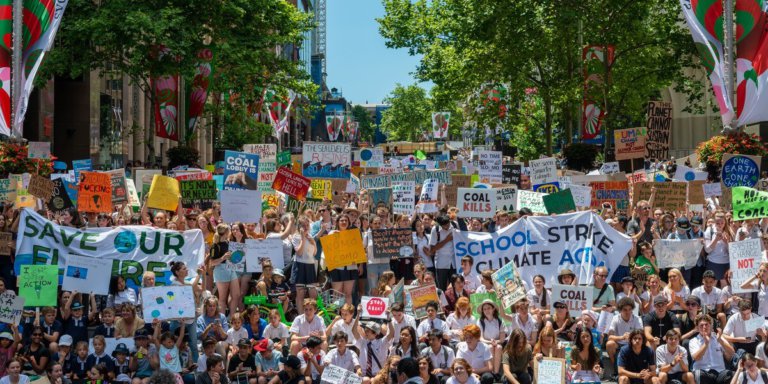
There has been plenty of debate surrounding climate change education in schools, stemming from the recent student-led strikes.
Youth activist Greta Thunberg started a movement when she began advocating for climate change awareness, encouraging students to take it upon themselves to incite change because the youth are not given adequate climate change education in schools.
Schools in several countries have started educating students on climate change, but as it’s a relatively new addition to the curriculum, not all are doing so effectively.
One country in Asia that’s leading the way in climate change education is Cambodia.
According to WeForum, “Students in Cambodia experience climate change firsthand. For the second time in four years, school hours had to be reduced across the country, due to record heat waves in the dry season. Now those students are becoming part of the effort to find solutions, a vanguard for the existential threat of our time.”
#IPCC Bureau member Joy Pereira discusses climate impacts and adaptation with students at Cambodia’s Angkor High School in Siem Reap #climatechange pic.twitter.com/8H8XZlKD8x
— IPCC (@IPCC_CH) May 28, 2019
Supported by the European Union, Sweden and the United Nations Development Programme, the country has integrated climate change into a new and expanded earth science curriculum for higher secondary schools, to be introduced by 2020.
“Students from grades 10 to 12 will learn about factors that drive climate change and the vulnerability profile of the country. They will also learn about key approaches and technologies, to adapt to the impacts of climate change and to reduce emissions of greenhouse gases.”
Why is climate change education so important?

Kids are often hearing about climate change in the news, and there have been reports that it’s causing them to feel fear and anxiety, which defeats the object of climate change education.
As The Guardian reported, “To date, many attempts to educate the public – and our kids – about climate change have relied on scare tactics that focus on superstorms, massive floods and ominous weather patterns to generate fear. But fear actually can inhibit the desire to learn more and take action – particularly in young people.”
Young learners need academic reasoning and structure in order to contextualise climate change and have an outlet to ask questions that will help put their fear at ease.
Teaching kids about climate change is not solely to spur them on to take action and do their part for their environment, although that is, of course, one aspect of it.
It’s also to prepare them for the future as kids will be growing up in an era where they will likely be responsible for developing climate change solutions .
“The trouble is that today’s students will be tasked with managing tomorrow’s climate change impact – and jobs requiring science, technology, engineering and math (STEM) skills already are on the rise.
“That demand will only continue to expand as the effects of climate change progress and more effort is needed to create and execute mitigation tactics and adaptation plans.”
While it will take some time for climate change education in schools to become the norm, there are some recurring themes that are frequently brought up when discussing how to teach this topic effectively.
Integrating climate change education within curriculum
Ensuring the curriculum @PLC_Pathways prepares students for the 21st century is a priority. Both primary & secondary students shared their views on climate change with our school business manager & what the school can do to reduce reuse & recycle in the coming year 🌍 pic.twitter.com/yMeTSrcqxN
— Pathways Learning Centre (@PLC_Pathways) August 9, 2019
Instead of teaching climate change as a subject on its own, several educators are pushing for the topic to be embedded in different subjects.
Joseph Henderson, who teaches in the environmental studies department at Paul Smith’s College in upstate New York, studies how climate change is taught in schools and believes it must be taught across many subjects, according to NPR.
He said, “For so long this has been seen as an issue that is solely within the domain of science. There needs to be a greater engagement across disciplines, particularly looking at the social dimensions,(such as the displacement of populations by natural disasters).”
A good example is how Rebecca Meyer, an eighth-grade English language arts teacher at Bronx Park Middle School in New York City, went about it – by assigning a 2013 novel by Mindy McGinnis titled Not a Drop to Drink to her students.
She said, “As we read the novel, kids made connections between what is happening today and the novel.
“At the end of the unit, as a culminating project, students chose groups, researched current solutions for physical and economic water scarcity and created PSA videos using iMovie about the problem and how their solution could help to combat the issue.”
Leading by example
With the advent of #ClimateChange and rising #GlobalWarming, Cambridge Court Group of Schools understand the importance of preserving natural resources like groundwater.#WhyCambridgeCourt #CambridgeCourtDifference #CambridgeCourtJaipur #Education #RisingHigh #WhyCCWS pic.twitter.com/30XykORFsz
— Cambridge Court Group Of Schools (@GroupCourt) August 6, 2019
In the era of hands-on learning, it seems likely that students will learn about climate change if they see it first-hand.
Schools that want to impart climate change education on the youth must also be sure that they are leading by example in terms of sustainability and being environmentally-friendly.
For example, if they are teaching students how the Earth is suffering because of single-use plastic, they should make efforts to curb plastic waste in school cafeterias.
Fiona Carnie, Director of Alternatives in Education, wrote for SchoolsWeek, “St Martin’s Primary School in Devon has a recycling policy which commits students and staff to reduce the amount of materials we use and waste we produce, re–use materials wherever possible, restore what is deemed to have been destroyed and respect our neighbours and our environment.”
They can also start projects with the students to provide them with a more practical way of learning about climate change.
Mairs Ryan, a science teacher at St. Gregory the Great Catholic School in San Diego, told NPR that she started a school garden for this purpose.
“The sixth-graders oversee the school garden, as well as our vermin composting bin, christened the ‘Worm Hotel’. The garden is their lab and the students ‘live and learn’ soil carbon sequestration and regenerative agriculture.
“Our school’s compost bin is evidence that alternatives exist to methane-producing landfills. In looking for more solutions to reduce methane, students debate food reuse practices around the world.”
When schools practice what they preach, the impact on young minds is stronger and they can see firsthand how they can actually make a difference in the environment.
Liked this? Then you’ll love…
How schools in Cambodia are actively tackling the climate crisis
Is it time for medical schools to incorporate climate change education?







